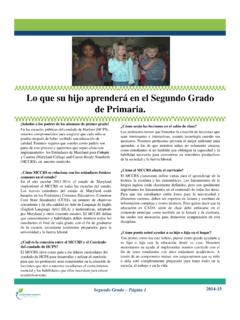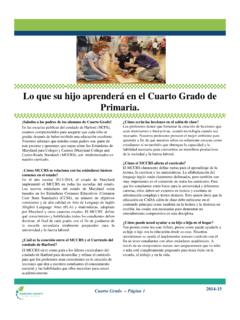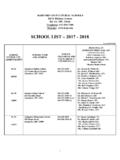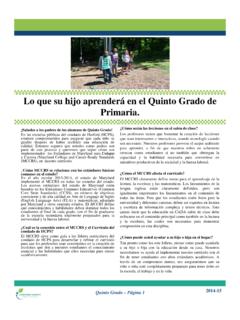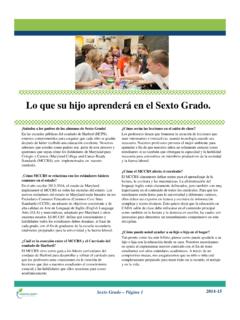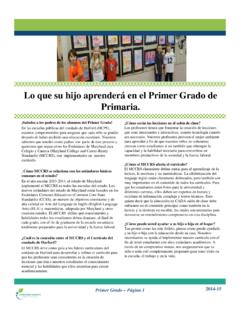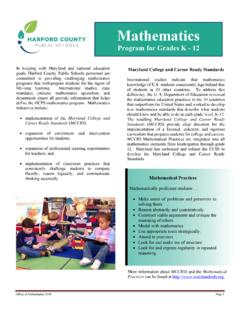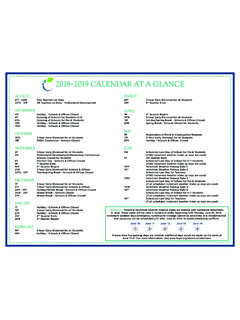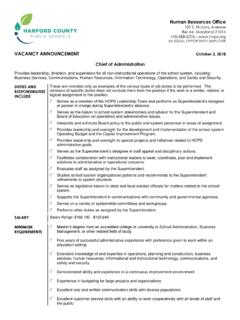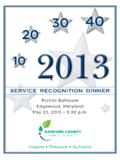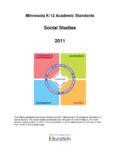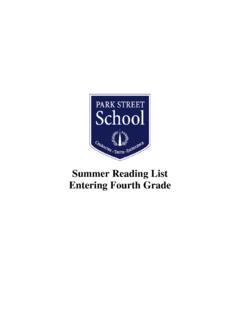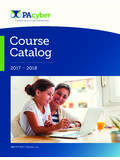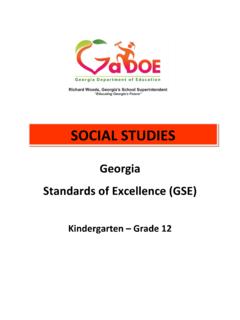Transcription of What Your Child Will Learn in Fourth Grade
1 2014-15 what your Child will Learn in Fourth Grade Greetings Fourth Grade Parents! In harford county public Schools (HCPS), we are committed to ensuring that every Child graduates having received an outstanding education. We know that you as parents are integral to this process and want you to know the role that the Maryland College and Career-Ready Standards (MCCRS) serve in the implementation of our curriculum. How do the MCCRS relate to the Common Core State Standards? In school year 2013-2014, Maryland implemented the MCCRS in all schools across the state. Maryland s new standards are based on the Common Core State Standards (CCSS), a set of consistent, high-quality academic goals in English language arts and mathematics, adopted by Maryland and more than 40 other states.
2 The MCCRS define the knowledge and skills all students should master by the end of each Grade level in order to graduate from high school fully prepared to enter college and the workforce. what is the connection between the MCCRS and the HCPS curriculum? The MCCRS guide HCPS instructional leaders to develop and refine curriculum so that teachers consistently create lessons that give our students the most essential knowledge and skills they need to progress academically. what will lessons look like in the classroom? Teachers are encouraged to create engaging and interactive lessons, integrating technology when appropriate.
3 Our teachers provide the best environment for learning so that our children grow as learners but also gain the content and skills necessary to become productive members of our workforce and society. How do the MCCRS affect all content areas? The MCCRS clearly define benchmarks for learning in reading, writing, and mathematics. The literacy expectations for English language arts are clearly outlined, but just as importantly, so are the expectations for literacy in all content areas. For students to be college and career ready, they must be proficient in reading and writing complex informational and technical texts.
4 This means that instruction in EVERY classroom focuses on both the critical content as well as the reading and writing skills necessary to demonstrate a comprehensive understanding of that discipline. How can you support your Child at home? As you review this brochure, think about ways you can support your Child s learning at home. We need your help as we implement our curriculum and hold students to the highest standards of academic performance. Through a strong partnership with you, we will ensure that your Child is fully prepared for success in school , work, and life. 2014-15 A Sample of what your Child will Learn ENGLISH LANGUAGE ARTS Reading Refer to examples in a text in order to explain what is directly stated and to draw inferences.
5 Determine the theme and summarize the text. Compare and contrast the point of view from which different stories are narrated. Describe the overall structure ( , sequential, cause/effect, problem/solution) of a text. Explain how an author uses reasons and evidence to support particular points in a text. Integrate information from two texts on the same topic in order to write or speak about the subject. Writing Write opinion pieces on topics or texts supporting a point of view with reasons and information. Introduce the topic or text clearly, provide reasons that are supported by facts and details, and provide a concluding statement. Write informative texts to examine a topic.
6 Use facts, definitions, concrete details, and quotations. Provide a concluding statement or section. Write narratives to develop real or imagined experiences or events using descriptive details, clear event sequences, and dialogue as necessary. Speaking and Listening Paraphrase portions of a text read aloud or information presented in diverse media and formats. Report on a topic or text, tell a story, or recount an experience in an organized manner using appropriate facts and relevant/descriptive details. Language Produce complete sentences, recognizing and correcting inappropriate fragments and run-ons. Use commas and quotation marks to mark direct speech and quotations from a text.
7 MATHEMATICS Algebra, Patterns, and Functions State the rule for a given pattern. Express numeric relationships using <, >, and =. Complete a function table when given the rule. Number Relationships and Operations Name and write numbers to 1,000,000. Determine common factors for numbers. Add and subtract decimals through hundredths. Multiply four-digit by one-digit numbers. Divide four-digit numbers by one-digit with remainders. Geometry Describe characteristics of shapes including congruency, similarity, and symmetry. Label angles. Distinguish between similar and congruent figures. Identify radius, diameter, and chord of a circle. Measurement Compare temperatures and tell time to one minute.
8 Solve problems with area, perimeter, and volume. Data Analysis and Probability Observe patterns, make predictions, and apply basic probability concepts to problem-solving situations. Determine outcomes using tree diagrams. State probability as a fraction. Mathematical Practices Make sense of and persevere in solving problems. Reason abstractly and quantitatively. Construct viable arguments and critique the reasoning of others. Model with mathematics, use appropriate tools strategically, and attend to precision. Look for and make use of structure as well as express regularity in repeated reasoning. Fourth Grade Page 2 2014-15 A Sample of what your Child will Learn SCIENCE Construct Knowledge Recognize and explain how physical weathering and erosion cause changes to Earth's surface.
9 Cite and describe the processes that cause rapid or slow changes in Earth's surface. Explain how rock is formed from combinations of different minerals and that smaller rocks come from the breakage and weathering of bedrock (solid rock underlying soil components) and larger rocks; soil is made partly from weathered rock, partly from plant remains-and also contains many living organisms. Recognize and explain that fossils provide evidence about the plants and animals that lived long ago and about the nature of the environment at that time. Apply Evidence and Reasoning Explain ways that individuals and groups of organisms interact with each other and their environment.
10 Provide evidence to support the fact that matter has observable and measurable properties. Provide evidence to illustrate that when a new material is made by combining two or more materials, its properties are different from the original materials. Understand and Use Technology Gather and question data from many different forms of scientific investigations which include reviewing appropriate print resources, observing what things are like or what is happening somewhere, collecting specimens for analysis, and doing experiments. Develop designs and analyze the products. Investigate a variety of mechanical systems and analyze the relationship among the parts.
